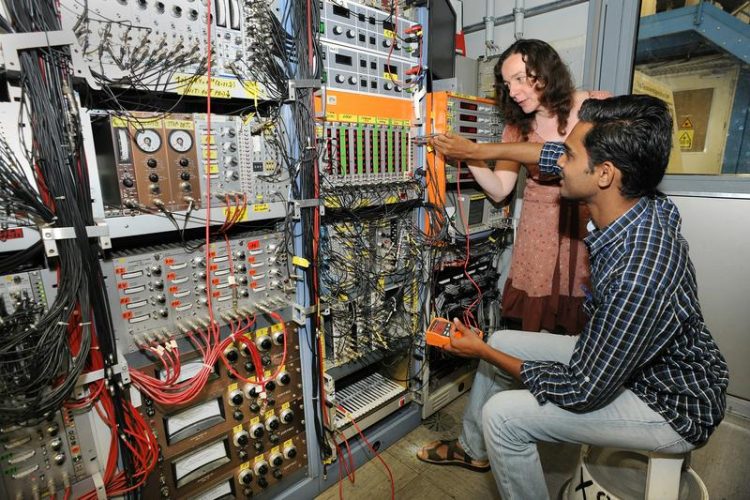Four new atomic nuclei discovered

Final preparations: the head of the experiment, Dr. Sophia Heinz, of GSI and Devaraja Malligenahalli, a student from the Manipal Centre for Natural Sciences, working on the experiment’s electronics. Copyright: G. Otto, GSI Helmholtzzentrum für Schwerionenforschung
For the experiment, the scientists shot at a 300-nanometer-thick foil of curium with accelerated calcium nuclei. In the collisions studied, the atomic nuclei of the two elements touched, and formed a compound system for an extremely short time.
Before the compound system could break apart again, after about a sextillionth of a second, the two nuclei involved exchanged a number of their nuclear building-blocks — protons and neutrons. Different isotopes formed as the end products of this exchange.
The isotopes of berkelium, neptunium, and americium discovered in the GSI experiment were created as the end products of such collisions. They are unstable and decay after a few milliseconds or seconds, depending on the isotope. All of the resulting decay products can be separated and analyzed using special filters composed of electrical and magnetic fields. The scientists used all of the decay products detected to identify the new isotope that has been created.
Every chemical element comes in the form of different isotopes. These isotopes are distinguished from one another by the number of neutrons in the nucleus, and thus by their mass. The newly discovered isotopes have fewer neutrons and are lighter than the previously known isotopes of the respective elements.
Due to their low number of neutrons, their structure is very exotic and therefore interesting for the development of theoretical models describing atomic nuclei. To date, we know of around 3,000 isotopes of the 114 chemical elements of the periodic system. According to scientific estimates, more than 4,000 additional, undiscovered isotopes should also exist. The hunt for these unknown isotopes goes on at GSI. Atoms that are heavier than uranium are especially interesting in this hunt.
“By using this method, we have succeeded in generating many different atomic nuclei at once,” says Sophia Heinz, the head of the experiment. “Our results are especially important for the study of super-heavy elements. New isotopes, in particular those of super-heavy elements, which contain an especially large number of neutrons, cannot be made by any other method. Experiments aimed at creating these neutron-rich nuclei are already being prepared.”
The current experiments will make it possible to explore previously unknown areas on the isotope chart. The elements 107 to 112 were discovered using the same experimental facility at GSI. The mechanisms responsible for the production of new isotopes will also be studied at the planned accelerator center FAIR in the future.
By the discovery of the four new isotopes, on the ranking list GSI moves closer to the laboratory which discovered the most isotopes. Head of the ranking list at the moment is the Lawrence Berkeley National Laboratory in the USA. GSI is on the second place.
The experiment at the GSI accelerator facility was carried out by an international team of researchers. Participants included the GSI Helmholtzzentrum für Schwerionenforschung, scientists from the Manipal Centre for Natural Sciences in India, the Justus Liebig University Giessen, the Japan Atomic Energy Agency, Lawrence Livermore National Laboratory in the USA, and the Joint Institute for Nuclear Research in Russia.
https://www.gsi.de/en/start/news/detailseite/2015/08/31/four-new-atomic-nuclei-d…
Media Contact
All latest news from the category: Physics and Astronomy
This area deals with the fundamental laws and building blocks of nature and how they interact, the properties and the behavior of matter, and research into space and time and their structures.
innovations-report provides in-depth reports and articles on subjects such as astrophysics, laser technologies, nuclear, quantum, particle and solid-state physics, nanotechnologies, planetary research and findings (Mars, Venus) and developments related to the Hubble Telescope.
Newest articles

Properties of new materials for microchips
… can now be measured well. Reseachers of Delft University of Technology demonstrated measuring performance properties of ultrathin silicon membranes. Making ever smaller and more powerful chips requires new ultrathin…

Floating solar’s potential
… to support sustainable development by addressing climate, water, and energy goals holistically. A new study published this week in Nature Energy raises the potential for floating solar photovoltaics (FPV)…

Skyrmions move at record speeds
… a step towards the computing of the future. An international research team led by scientists from the CNRS1 has discovered that the magnetic nanobubbles2 known as skyrmions can be…





















